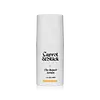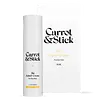What's inside
What's inside
 Key Ingredients
Key Ingredients

 Benefits
Benefits

 Concerns
Concerns

No concerns
 Ingredients Side-by-side
Ingredients Side-by-side

Water
Skin ConditioningNiacinamide
SmoothingGlycerin
HumectantAcacia Senegal Gum
MaskingHydrolyzed Rhizobian Gum
Camellia Sinensis Leaf Extract
AntimicrobialChamomilla Recutita Flower Extract
MaskingPCA
HumectantSodium PCA
HumectantSh-Oligopeptide-1
Skin ConditioningSh-Oligopeptide-2
Skin ConditioningSh-Polypeptide-1
Skin ConditioningSh-Polypeptide-11
Sh-Polypeptide-9
Skin ConditioningSodium Hyaluronate
HumectantAcetyl Hexapeptide-8
HumectantArginine
MaskingAspartic Acid
MaskingAcetyl Glutamine
Skin ConditioningLecithin
EmollientCarnitine
CleansingAlanine
MaskingGlycine
BufferingHistidine
HumectantIsoleucine
Skin ConditioningPhenylalanine
MaskingProline
Skin ConditioningSerine
MaskingThreonine
Valine
MaskingCaffeine
Skin ConditioningRuscus Aculeatus Root Extract
AstringentChenopodium Quinoa Seed Extract
Skin ConditioningBacillus
Skin ConditioningCitrus Reticulata Peel Extract
Skin ConditioningCodonopsis Lanceolata Extract
AntioxidantCoix Lacryma-Jobi Ma-Yuen Seed Extract
Skin ConditioningChrysanthemum Parthenium Extract
Skin ConditioningDigitaria Ciliaris Flower Extract
EmollientGlycyrrhiza Glabra Root Extract
BleachingNelumbo Nucifera Seed Extract
AntimicrobialPaeonia Suffruticosa Root Extract
Skin ProtectingPaeonia Albiflora Flower Extract
TonicPolygonum Odoratum Extract
Skin ConditioningSodium Lactate
BufferingPolyglutamic Acid
Skin ConditioningXanthan Gum
EmulsifyingButylene Glycol
Humectant1,2-Hexanediol
Skin ConditioningCitric Acid
BufferingCaprylyl Glycol
EmollientSodium Benzoate
MaskingSodium Levulinate
Skin ConditioningPotassium Sorbate
PreservativePhenoxyethanol
PreservativeWater, Niacinamide, Glycerin, Acacia Senegal Gum, Hydrolyzed Rhizobian Gum, Camellia Sinensis Leaf Extract, Chamomilla Recutita Flower Extract, PCA, Sodium PCA, Sh-Oligopeptide-1, Sh-Oligopeptide-2, Sh-Polypeptide-1, Sh-Polypeptide-11, Sh-Polypeptide-9, Sodium Hyaluronate, Acetyl Hexapeptide-8, Arginine, Aspartic Acid, Acetyl Glutamine, Lecithin, Carnitine, Alanine, Glycine, Histidine, Isoleucine, Phenylalanine, Proline, Serine, Threonine, Valine, Caffeine, Ruscus Aculeatus Root Extract, Chenopodium Quinoa Seed Extract, Bacillus, Citrus Reticulata Peel Extract, Codonopsis Lanceolata Extract, Coix Lacryma-Jobi Ma-Yuen Seed Extract, Chrysanthemum Parthenium Extract, Digitaria Ciliaris Flower Extract, Glycyrrhiza Glabra Root Extract, Nelumbo Nucifera Seed Extract, Paeonia Suffruticosa Root Extract, Paeonia Albiflora Flower Extract, Polygonum Odoratum Extract, Sodium Lactate, Polyglutamic Acid, Xanthan Gum, Butylene Glycol, 1,2-Hexanediol, Citric Acid, Caprylyl Glycol, Sodium Benzoate, Sodium Levulinate, Potassium Sorbate, Phenoxyethanol
Water
Skin ConditioningCaprylic/Capric Triglyceride
MaskingLactobacillus Ferment
Skin ConditioningCetearyl Olivate
Cetearyl Alcohol
EmollientButyrospermum Parkii Butter
Skin ConditioningMacadamia Ternifolia Seed Oil
EmollientCocos Nucifera Oil
MaskingSimmondsia Chinensis Seed Oil
EmollientHelianthus Annuus Seed Oil
EmollientPropanediol
SolventCucumis Sativus Fruit Extract
EmollientCamellia Sinensis Leaf Extract
AntimicrobialAloe Barbadensis Leaf Extract
EmollientChamomilla Recutita Flower Extract
MaskingHyaluronic Acid
HumectantNiacinamide
SmoothingPanthenol
Skin ConditioningTocopheryl Acetate
AntioxidantEthylhexylglycerin
Skin ConditioningPhenoxyethanol
PreservativeXanthan Gum
EmulsifyingWater, Caprylic/Capric Triglyceride, Lactobacillus Ferment, Cetearyl Olivate, Cetearyl Alcohol, Butyrospermum Parkii Butter, Macadamia Ternifolia Seed Oil, Cocos Nucifera Oil, Simmondsia Chinensis Seed Oil, Helianthus Annuus Seed Oil, Propanediol, Cucumis Sativus Fruit Extract, Camellia Sinensis Leaf Extract, Aloe Barbadensis Leaf Extract, Chamomilla Recutita Flower Extract, Hyaluronic Acid, Niacinamide, Panthenol, Tocopheryl Acetate, Ethylhexylglycerin, Phenoxyethanol, Xanthan Gum
Ingredients Explained
These ingredients are found in both products.
Ingredients higher up in an ingredient list are typically present in a larger amount.
Camellia Sinensis Leaf Extract is derived from the leaves of the tea plant. Black tea, green tea, and oolong tea are all harvested from this plant.
This ingredient has many skin benefits:
This ingredient contains polyphenols, a strong antioxidant. Antioxidants help fight off molecules that damage skin cells.
On top of that, the antioxidants in green tea neutralize free-radicals from the sun. This gives the skin some extra UV protection, but should not replace sunscreen.
Many components of tea have anti-inflammatory properties.
Polyphenols and L-theanine help soothe the skin and reduce irritation. The caffeine in Camellia Sinensis Leaf Extract helps calm inflamed blood vessels.
Other compounds found in tea include: Vitamin Bs, linoleic acid, magnesium, calcium, iron, and zinc.
Research has shown both drinking Camellia Sinensis Leaf Tea and applying it to the skin can help boost skin elasticity and hydration. Studies also show using tea extract may reduce sebum, or oil, production.
Learn more about Camellia Sinensis Leaf ExtractChamomilla Recutita Flower Extract comes from the Chamomile flower.
Chamomile is rich in antioxidants and has anti-inflammatory properties. Several compounds found in chamomile help with soothing, such as bisbolol.
Antioxidant components in chamomile make it an effective ingredient to help slow the signs of aging. Antioxidants help fight free-radical molecules, or molecules that may damage your skin.
Essential oils from chamomile have been found to improve wound healing due to its antimicrobial properties.
Ancient Greeks and Egyptians used Chamomile to treat skin redness and dryness. Chamomile has also been used to help treat stomach issues.
Learn more about Chamomilla Recutita Flower ExtractNiacinamide is a multitasking form of vitamin B3 that strengthens the skin barrier, reduces pores and dark spots, regulates oil, and improves signs of aging.
And the best part? It's gentle and well-tolerated by most skin types, including sensitive and reactive skin.
You might have heard of "niacin flush", or the reddening of skin that causes itchiness. Niacinamide has not been found to cause this.
In very rare cases, some individuals may not be able to tolerate niacinamide at all or experience an allergic reaction to it.
If you are experiencing flaking, irritation, and dryness with this ingredient, be sure to double check all your products as this ingredient can be found in all categories of skincare.
When incorporating niacinamide into your routine, look out for concentration amounts. Typically, 5% niacinamide provides benefits such as fading dark spots. However, if you have sensitive skin, it is better to begin with a smaller concentration.
When you apply niacinamide to your skin, your body converts it into nicotinamide adenine dinucleotide (NAD). NAD is an essential coenzyme that is already found in your cells as "fuel" and powers countless biological processes.
In your skin, NAD helps repair cell damage, produce new healthy cells, support collagen production, strengthen the skin barrier, and fight environmental stressors (like UV and pollution).
Our natural NAD levels start to decline with age, leading to slower skin repair, visible aging, and a weaker skin barrier. By providing your skin niacinamide, you're recharging your skin's NAD levels. This leads to stronger, healthier, and younger looking skin.
Another name for vitamin B3 is nicotinamide. This vitamin is water-soluble and our bodies don't store it. We obtain Vitamin B3 from either food or skincare. Meat, fish, wheat, yeast, and leafy greens contain vitamin B3.
The type of niacinamide used in skincare is synthetically created.
Learn more about NiacinamidePhenoxyethanol is a preservative that has germicide, antimicrobial, and aromatic properties. Studies show that phenoxyethanol can prevent microbial growth. By itself, it has a scent that is similar to that of a rose.
It's often used in formulations along with Caprylyl Glycol to preserve the shelf life of products.
Water. It's the most common cosmetic ingredient of all. You'll usually see it at the top of ingredient lists, meaning that it makes up the largest part of the product.
So why is it so popular? Water most often acts as a solvent - this means that it helps dissolve other ingredients into the formulation.
You'll also recognize water as that liquid we all need to stay alive. If you see this, drink a glass of water. Stay hydrated!
Learn more about WaterXanthan gum is used as a stabilizer and thickener within cosmetic products. It helps give products a sticky, thick feeling - preventing them from being too runny.
On the technical side of things, xanthan gum is a polysaccharide - a combination consisting of multiple sugar molecules bonded together.
Xanthan gum is a pretty common and great ingredient. It is a natural, non-toxic, non-irritating ingredient that is also commonly used in food products.
Learn more about Xanthan Gum